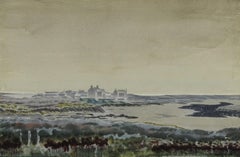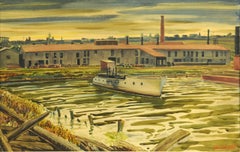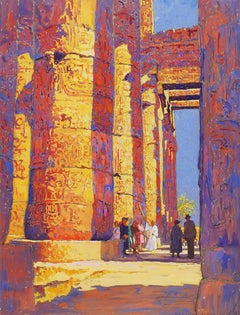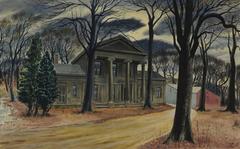Edward Dobrotka Landscape Drawings and Watercolors
to
2
1
2
1
1
Overall Height
to
Overall Width
to
1
1
1
1
1
1
2
2
2
85
59
52
52
2
2
Artist: Edward Dobrotka
Irish Sea
By Edward Dobrotka
Located in Fairlawn, OH
Irish Sea
Watercolor, 1947
Signed and dated by the artist lower right
Condition: Excellent
Image/Sheet size: 12 x 18 inches
Provenance: Estate of the Artist
...
Category
1940s American Realist Edward Dobrotka Landscape Drawings and Watercolors
Materials
Watercolor
Breaking Up of the Penelope
By Edward Dobrotka
Located in Fairlawn, OH
Breaking Up of the Penelope
watercolor on artists watercolor board, 1942
Signed and dated by the artist lower right (see photo)
Exhibitions:
Cleveland, OH, The Cleveland Museum of Art, May 3 - June 11, 1944: "The 26th Annual Ehibition of Works by Artists and Craftsmen of the Western Reserve," , (label on verso)
Youngstown OH, The Butler Insititue of American Art, 1943: "1943 New Year Show," , (label on verso)
"Ed Dobrotka was one of comic-book illustrator Joe Shuster's early assistants. In the studio, he worked on the 'Superman' series, inking the pencils of artists including Shuster, John Sikela, Leo Nowak and Wayne Boring.
Dobrotka did do some pencilling of his own, however he returned to inking exclusively in 1945. In the following years, he worked with Sikela on the 'Superboy' series until the 1950s. He has also work on the solo 'Lois Lane...
Category
1940s American Realist Edward Dobrotka Landscape Drawings and Watercolors
Materials
Watercolor
Related Items
Tourists Viewing the Temple of Karnak, Egypt
By Eleanor Parke Custis
Located in New York, NY
Eleanor Park Custis painted scenes as varied as the artist's travels: from her hometown of Washington, D.C., to the coastal towns of New England; from the prosperous fishing villages of Brittany, to Venice and the mountain villages and lakes of northern Italy.
While Custis's subjects are diverse, her style is consistent and distinctive throughout this body of work. Her use of flat areas of color delineated by dark contours is reminiscent of the aesthetics of woodblock printing. Like many artists of the day, she was profoundly influenced by Japanese woodblock prints, and her adaptation of the aesthetic by 1924 led to her most productive artistic period.
Eleanor Custis hailed from a socially prominent Washington, D.C., family. She was distantly related to Martha Custis Washington, America's first First Lady. Custis began three years of formal art training in the autumn of 1915 at the Corcoran School of Art in Washington, and was guided and inspired by Impressionist artist Edmund C. Tarbell, one of the Ten American Painters, who became the Corcoran School's principal in 1918. Custis exhibited widely in many of the Washington art societies and clubs for much of her career. She was also a frequent exhibitor at the Grand Central Art Galleries in New York City; her last one-woman show there was in April 1945.
Custis's mature style emerged in scenes of the streets, wharves, and drydocks of seacoast villages from Maine to Massachusetts, which she visited during the summers of 1924 and 1925. She was working in Gloucester, Massachusetts in August 1924, and painted several gouaches of the town's wharves and winding streets, including In Gloucester Harbor and At the Drydock, Gloucester. During her stay, Custis may have met Jane Peterson or at least must have seen her work, the best of which was executed in Gloucester during the preceding ten years. The similarity between their styles is unmistakable, but, while it may be tempting to suggest that Custis was influenced by Peterson during her summer in Gloucester, the connection between their work is probably more a case of shared aesthetics and common European influences.
Custis expanded her subject repertoire with three trips to Europe between 1926 and 1929, and was inspired by the Old World charm of Holland, northern France, Switzerland, and Italy, leading to such works as New Kirk, Delft, Holland, Market Day in Quimper, At the Foot of the Matterhorn, and The Town Square, Varenna. A Mediterranean cruise in 1934 introduced her to the Near East, and the bustling, colorful streets and bazaars of Cairo, captured in works like A Street in Cairo, Egypt and A Moroccan Jug...
Category
20th Century American Realist Edward Dobrotka Landscape Drawings and Watercolors
Materials
Paper, Gouache
"The Red Silo" Winold Reiss, Rural Regionalist Landscape, Sunny Day on Farm
By Winold Reiss
Located in New York, NY
Winold Reiss
The Red Silo
Signed lower left
Watercolor on paper
20 x 29 inches
Winold Reiss (1886-1953) was an artist and designer who emigrated to the United States from Germany in 1913. Probably best known as a portraitist, Reiss was a pioneer of modernism and well known for his brilliant work in graphic and interior design. A compassionate man who greatly respected all people as human beings, he believed that his art could help break down racial prejudices. Like his father Fritz Reiss (1857-1915), who was also an artist and who was his son's first teacher, Winold Reiss was artistically moved by diverse cultures. The elder Reiss focused on folk life in Germany while Winold drew substantial inspiration from a range of cultures, particularly Native American, Mexican, and African-American.
As did many young aspiring artists, Winold Reiss studied with the esteemed painter and teacher Franz von Stuck at the Royal Academy of Fine Arts in Munich, which was at that time a center of the decorative and fine-arts movement. It is not known whether Reiss met E. Martin Hennings...
Category
Mid-20th Century American Realist Edward Dobrotka Landscape Drawings and Watercolors
Materials
Paper, Watercolor
Irises Ink, Watercolor, Oil on Yupo paper 26” x 40” Framed 31 ¼” x 45 ¼”
Located in Houston, TX
Yellow Poppies by Texas artist Julie England is an Ink and Watercolor, Oil on Yupo paper. The size of Yellow Poppies is Image 26” x 40” Framed 31 ¼” x 45 ¼” Yellow Poppies by J...
Category
2010s American Realist Edward Dobrotka Landscape Drawings and Watercolors
Materials
Oil, Watercolor, Mixed Media
Cool Afternoon Oil Watercolor Yupo Paper 11″ x 14″ Image 16″ x 21 3/4″ Frame
Located in Houston, TX
Cool Afternoon by Texas artist Julie England is an Ink and Watercolor, Oil on Yupo paper. The size of Cool Afternoon is 11″ x 14″ Image
16″ x 21 3/4″...
Category
2010s American Realist Edward Dobrotka Landscape Drawings and Watercolors
Materials
Watercolor, Oil
Hemlock--Selden's Neck, Lyme, Connecticut
By Charles De Wolf Brownell
Located in New York, NY
Framed, 5.25 x 8.5 x 1.5 in.
Category
19th Century American Realist Edward Dobrotka Landscape Drawings and Watercolors
Materials
Watercolor
Delaware & Hudson Canal, Ellenville NY watercolor by Edward Lamson Henry
By Edward Lamson Henry
Located in Hudson, NY
Original watercolor by Edward Lamson Henry looking back at barge travel through small New York state towns.
Delaware & Hudson Canal, Ellenville N...
Category
Early 1900s American Realist Edward Dobrotka Landscape Drawings and Watercolors
Materials
Paper, Watercolor
Thomaston Maine, Original Rooftop View Townscape in Watercolor
Located in Doylestown, PA
"Thomaston, Maine" is a 15 x 13.5 inches, watercolor townscape, signed in the lower left, and framed behind glass.
Ranulph Bye was born in 1916 in Princet...
Category
20th Century American Realist Edward Dobrotka Landscape Drawings and Watercolors
Materials
Watercolor, Archival Paper
Passaic Falls in New Jersey
By Nicolino V. Calyo
Located in New York, NY
Nicolino Calyo's career reflects a restless spirit of enterprise and adventure. Descended in the line of the Viscontes di Calyo of Calabria, the artist was the son of a Neapolitan army officer. (For a brief biographical sketch of the artist see Philadelphia Museum of Art, Pennsylvania, Philadelphia: Three Centuries of American Art, exhib. cat. [1976], pp. 299-301 no. 257.) Calyo received formal training in art at the Naples Academy. His career took shape amidst the backdrop of the political turbulence of early nineteenth-century Italy, Spain, and France. He fled Naples after choosing the losing side in struggles of 1820-21, and, by 1829, was part of a community of Italian exiles in Malta. This was the keynote of a peripatetic life that saw the artist travel through Europe, to America, to Europe again, and back to America.
Paradoxically, Calyo’s stock-in-trade was close observation of people and places, meticulously rendered in the precise topographical tradition of his fellow countrymen, the eighteenth-century
vedute painters Antonio Canale (called Canaletto) and Francesco Guardi. In search of artistic opportunity and in pursuit of a living, Calyo left Malta, and, by 1834, was in Baltimore, Maryland. He advertised his skills in the April 16, 1835 edition of the Baltimore American, offering "remarkable views executed from drawings taken on the spot by himself, . . . in which no pains or any resource of his art has been neglected, to render them accurate in every particular" (as quoted in The Art Gallery and The Gallery of the School of Architecture, University of Maryland, College Park, 350 Years of Art & Architecture in Maryland, exhib. cat. [1984], p. 35). Favoring gouache on paper as his medium, Calyo rendered faithful visual images of familiar locales executed with a degree of skill and polish that was second nature for European academically-trained artists. Indeed, it was the search for this graceful fluency that made American artists eager to travel to Europe and that led American patrons to seek out the works of ambitious newcomers.
On June 16, 1835, the Baltimore Republican reported that Calyo was on his way north to Philadelphia and New York to paint views of those cities. Calyo arrived in New York, by way of Philadelphia, just in time for the great fire of December 1835, which destroyed much of the downtown business district. He sketched the fire as it burned, producing a series of gouaches that combined his sophisticated European painting style with the truth and urgency of on-the-spot observation. Two of his images were given broad currency when William James Bennett reproduced them in aquatint. The New-York Historical Society owns two large Calyo gouaches of the fire, and two others, formerly in the Middendorf Collection, are now in the collection of Hirschl & Adler Galleries. From 1838 until 1855, Calyo listed himself variously in the New York City directories as a painter, a portrait painter, and as an art instructor, singly, and in partnership with his sons, John (1818-1893) and later, the younger Hannibal (1835-1883). Calyo also attracted notice for a series of scenes and characters from the streets of New York, called Cries of New York. These works, which were later published as prints, participate in a time-honored European genre tradition. Calyo’s New York home became a gathering place for European exiles, including Napoleon III. Between 1847 and 1852 Calyo exhibited scenes from the Mexican War and traveled from Boston to New Orleans with his forty-foot panorama of the Connecticut River. Later, he spent time in Spain as court painter to Queen Maria Christina, the result of his continuing European connections, but he was back in America by 1874, where he remained until his death.
The Passaic River rises in the hills just south of Morristown, New Jersey, marking a serpentine eighty-mile course before it empties into Newark Bay. It flows north-northeast to Paterson, where it falls seventy feet in a spectacular cataract before continuing south through Passaic and Newark. William Gerdts, in Painting and Sculpture in New Jersey (1964, pp. 51-2), describes the falls as:
the most important [landscape] subject in New Jersey during the eighteenth and nineteenth centuries. . . . The Passaic Falls remained a popular spot, particularly during the romantic period. Indeed, newspapers, periodicals, and gift books contain many accounts of visits to the Falls, sentimental poems written about them or about a loved one visiting the Falls, or even, occasionally, in memory of one who perished in the waters of the Falls — usually intentionally. . . . Waterfalls . . . were popular among travelers in the period and the Passaic Falls were only surpassed by Niagara Falls and Trenton Falls...
Category
19th Century American Realist Edward Dobrotka Landscape Drawings and Watercolors
Materials
Paper, Gouache
"Backyards" Early 20th Century Watercolor Fauvism Social Realism American Scene
By Stuart Davis
Located in New York, NY
"Backyards" Early 20th Century Watercolor Fauvism Social Realism American Scene
Note: We have three similar in style works from 1911 available now on 1stDibs. All are framed identic...
Category
1910s American Realist Edward Dobrotka Landscape Drawings and Watercolors
Materials
Paper, Watercolor
Answering the Door Early 20th Century w/c Fauvism Social Realism American Scene
By Stuart Davis
Located in New York, NY
Answering the Door Early 20th Century w/c Fauvism Social Realism American Scene
Note: We have three similar in style works from 1911 available now on 1stDibs. All are framed identi...
Category
1910s American Realist Edward Dobrotka Landscape Drawings and Watercolors
Materials
Paper, Watercolor
Schooners along the Hudson, West Point Academy in the distance.
Located in Middletown, NY
A serene Hudson River scene by a student of Louis Comfort Tiffany.
Anna May Walling was born in 1881, a native of Goshen, New York. She was a graduate of the Blair Academy, and Prat...
Category
Early 20th Century American Realist Edward Dobrotka Landscape Drawings and Watercolors
Materials
Watercolor, Handmade Paper
“Work Day”
Located in Southampton, NY
Original watercolor on archival paper of a sailboat with a trailing dory heading out to sea. Attributed to the hand of Alexander Yaron. Signed lower right and dated 1980. Condition is excellent. Under glass. The artwork is matted and housed in a rounded front edge solid oak wood frame. Overall framed measurements are 27 by 34 inches. Provenance: A Sarasota, Florida gentleman.
Alexander A. Yaron was born in Estonia in 1910, lived in China and the Philippines before moving to the United States in the 1950’s. He lived in New York as well as in Anaheim, California where he has a working studio. An autodidact and a versatile commercial artist, Alexander Yaron applied his talent in portraiture, photography, interior design, advertising, layout and illustration. His best known projects were illustrated art...
Category
1980s American Realist Edward Dobrotka Landscape Drawings and Watercolors
Materials
Watercolor, Archival Paper
Previously Available Items
Arcady: Oswego - Ithaca Turnpike, New York State
By Edward Dobrotka
Located in Fairlawn, OH
Signed, titled, and dated by the artist lower right
Exhibitions:
Youngstown, OH, The Butler Insititute of American Art, 1946: "1946 New Year Show,",(label from verso of frame)
...
Category
1940s Edward Dobrotka Landscape Drawings and Watercolors
Materials
Watercolor
Edward Dobrotka landscape drawings and watercolors for sale on 1stDibs.
Find a wide variety of authentic Edward Dobrotka landscape drawings and watercolors available for sale on 1stDibs. You can also browse by medium to find art by Edward Dobrotka in paint, watercolor and more. Not every interior allows for large Edward Dobrotka landscape drawings and watercolors, so small editions measuring 18 inches across are available. Customers who are interested in this artist might also find the work of Don David, Joseph Yeager, and Dozier Bell. Edward Dobrotka landscape drawings and watercolors prices can differ depending upon medium, time period and other attributes. On 1stDibs, the price for these items starts at $700 and tops out at $3,500, while the average work can sell for $2,100.



